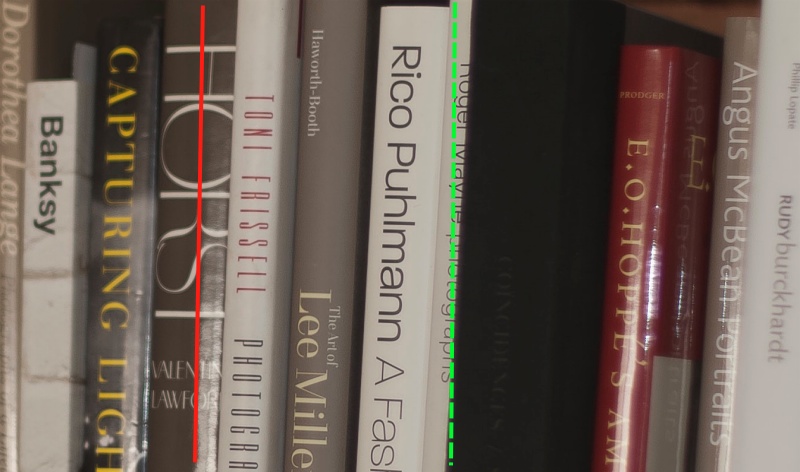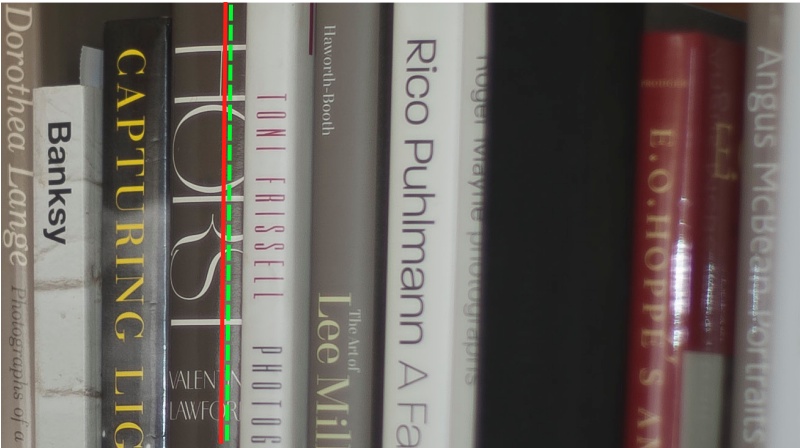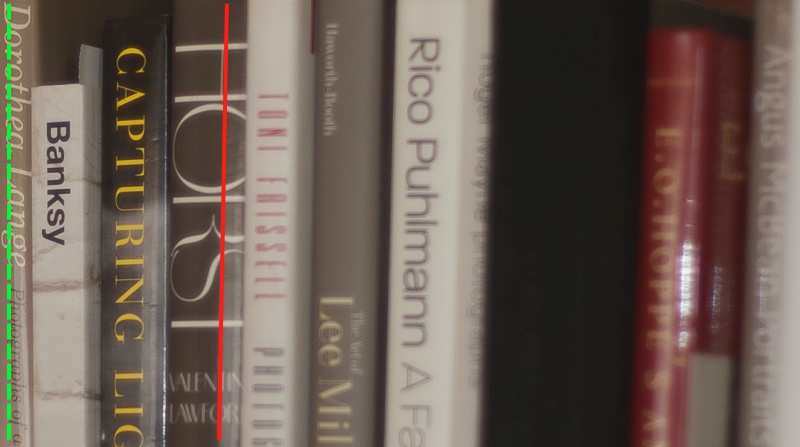The final touch.
In earlier pieces dealing with the installation of a CPU in old Manual Focus Nikkors, I have explained most of the benefits of CPU use. Further, by making tailored lens profiles, I have made it possible to get the best possible results as regards freedom from vignetting, distortion and chromatic aberration.
The last frontier is optimal focus.
When using MF lenses on the D700, which is blessed with a large, bright finder and an LED confirmation dot, with arrows showing which way to turn the lens when it’s not in focus, things are pretty easy. The LED is fairly accurate and the addition of a magnifying eyepiece further simplifies regular old screen focus, if the dot is not to your liking.
However, get in really close at f/1.4 with something like the Nikkor-S 50mm, f/1.4 and any errors start to show themselves.
To check things out, I placed the camera on a tripod with a QR head (to permit accurate replacement) at a roughly 45 degree angle to a bookcase and four feet distant. Not surprisingly, the contents are solely photography books! One snap was made with the single center focus rectangle placed on the ‘O’ in ‘HORST’.
I then loaded the image in LR4 and looked at the enlarged version to see what was what.
Well, the LED dot was wrong. I have marked the focus point and the point of sharpest focus on the image below.

Red line is where the LED dot focus was made. Green dotted line shows where the image is sharpest.
The sharpest focus is closer to the camera than the point at which focus was aimed.
The CPU installed in the lens permits adjustment of the point at which the LED illuminates. You can move that point back or forward in 8 discrete steps in either direction, making a total of 17 settings including the default. The provided instructions use English poorly and it’s hard to divine which way to go.
Here’s the rule. After doing the 1-6-1 second programming setup:
- If you hit the shutter release when the top LED panel indicates F10, the LED will illuminate at a shorter focus point distance from the camera as indicated on the lens, meaning further from infinity.
- If you hit the shutter release when the LED panel indicates F20, the LED will illuminate at a longer focus distance from the camera as indicated on the lens, meaning closer to infinity.
- Each subsequent shutter release at F10 or F20 will move the LED illumination point further in the respective direction.
Now the LED is not that sensitive. In practice there’s a small range (“more or less right”) where it stays illuminated and I simply oscillate the lens’s focus collar either side until I am centered on the focus range for the LED illumination point.
In the above example the LED was illuminating on a point too far from the camera as optimal focus was closer than the point at which the LED was aimed. Thus I needed to move the LED illumination point away from the camera, meaning that I operated the F20 switch in the programming instructions once.
I then refocused the lens on the ‘O’ in ‘HORST’ and took a second picture. Here is the result:

Red line is where the LED dot focus was made. Green dotted line shows where the image is sharpest.
Bingo! Bang on. The LED illumination and best focus point are identical.
Just to confirm, I then cycled the F20 one more time, moving the LED illumination point yet further away from the camera, with the focus collar set closer too infinity to illuminate the LED at the same point in the identically framed image.

Red line is where the LED dot focus was made. Green dotted line shows where the image is sharpest.
In the above example the LED was illuminating on a point too close to the camera as optimal focus was closer than the point at which the LED was aimed.
So I went through one F10 cycle to revert the optimal LED illumination point, as in the second picture above.
In practice, it’s really only necessary to do this with wide aperture lenses used at close distances, or extremely long focus lenses which have very shallow depth of field, like the 500mm Reflex Nikkor. In these circumstances, you must remember to do your critical focusing using the LED light not the focusing screen if you have found it necessary to move the LED illumination point using CPU programming.
But this absolutely puts the icing on the cake for fast and/or long MF Nikkors. For AF Nikkors (AF D or AF-S) a like functionality exists in the body of the camera in the rear LCD menus. With AF Nikkors the camera ‘remembers’ the setting for each lens; with MF + CPU lenses, each lens stores its own setting in the glued-on CPU. This does not address the case where the photographer wants to use the same MF + CPU lens on different Nikon (or Fuji) bodies. In that case, if the bodies differ significantly, it’s best to have the factory fix the body rather than trying to fix the lens.
I have only found it necessary to move the focus point on three lenses – the 50/1.4, the 85/1.8 and the 105/4 Micro – of the dozen I own. All the others are spot on including the 500mm f/8 Reflex! Why these two lenses should differ, I do not know, but differ they do, as multiple tests have consistently confirmed. Indeed, I only really started to see what the 105/4 Micro-Nikkor could do after this focus fine tuning process. It is ‘scary sharp’!
Is this all worth the effort? If you use the lens at f/1.4 or f/2, just check this out.
By the way, to learn more about Horst, one of the greatest fashion photographers of the twentieth century, click here.
Wow, that’s pretty cool! I didn’t know that add-on CPUs supported this feature. I’m guessing it’s exclusive to the model you have purchased?
Thanks in general for this series of posts about the D700 and manual-focus lenses! I’m using a D200 with a decent selection, but I’m using a Katz-eye screen with the traditional split-screen focusing.